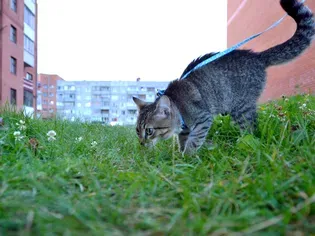How to Clicker Train Your Cat
Updated on 04/26/24

Unleash Your Cat's Superpowers with Clicker Training: The Ultimate Guide to Effective Communication
Cats, with their enigmatic charm and independent nature, have captivated countless hearts throughout history. While their innate curiosity and playful demeanor make them delightful companions, understanding their unique communication needs can sometimes pose a challenge. Enter clicker training, a revolutionary technique that empowers you to connect with your feline friend on a whole new level.
What is Clicker Training?
Clicker training is a positive reinforcement method that utilizes a small device called a clicker to mark the exact moment desired behaviors occur. This precise timing allows you to isolate and reward specific actions, shaping your cat's behavior without relying on physical force or punishment.
Why Clicker Train Your Cat?
The benefits of clicker training for cats are manifold. It can:
* Enhance communication and bonding between you and your pet
* Promote positive behavioral changes, such as reducing scratching or aggression
* Facilitate litter box training and grooming
* Address behavioral problems, such as anxiety or fear
* Provide mental stimulation and enrichment for your curious feline
Choosing the Right Clicker
Select a clicker that produces a clear, distinct sound that your cat can easily hear. Avoid clickers with multiple tones or that make excessive noise, as these can be confusing for cats.
Getting Started: The 3 Stages of Training
Clicker training involves three distinct stages:
1. Charging the Clicker:
Pair the clicker with a high-value treat that your cat loves. Click the device and immediately give the treat, repeating the process several times. This establishes the clicker as a signal for an impending reward.
2. Marking Desired Behaviors:
Once the clicker has been charged, start marking desired behaviors. Click the device as soon as your cat performs the action you wish to reinforce, such as sitting, coming to you when called, or using the litter box.
3. Reinforcing and Shaping:
Reward your cat with the treat immediately after each click. Gradually increase the duration or complexity of the desired behavior before clicking and rewarding. This process encourages your cat to refine its skills and develop new behaviors.
Common Training Scenarios
To illustrate the versatility of clicker training with cats, let's delve into a few practical training scenarios:
1. Litter Box Training:
* Start by placing a litter box in a quiet area accessible to your cat.
* Click and reward your cat when it shows interest in the box.
* Gradually lure your cat into the box using treats.
* Each time your cat uses the box appropriately, click and reward.
2. Reducing Scratching:
* Identify appropriate scratching surfaces, such as a scratching post or cardboard box.
* Click and reward your cat whenever it uses these surfaces.
* When your cat scratches inappropriate objects, redirect it to the designated scratching surfaces and click and reward.
3. Grooming:
* Start by gently brushing your cat for a few seconds.
* Click and reward your cat as soon as it remains calm and accepts the brushing.
* Gradually increase the duration and frequency of brushing as your cat becomes more comfortable.
Troubleshooting Tips
If you encounter challenges during clicker training, don't despair! Here are some helpful tips:
* Keep training sessions short and focused: Aim for 5-10 minute sessions initially and gradually increase the duration as your cat's attention span grows.
* Avoid over-rewarding: While treats are essential, use them sparingly and gradually reduce the frequency of rewards as your cat's behavior improves.
* Be patient and consistent: Clicker training requires patience and repetition. Stay positive and don't get discouraged if progress is slow.
* Seek professional help if needed: If you experience significant challenges or feel overwhelmed, don't hesitate to consult with a veterinarian or certified animal trainer.
Conclusion
Clicker training is an invaluable tool that empowers you to communicate effectively with your cat, nurture its intelligence, and build an unbreakable bond. By following the steps outlined in this comprehensive guide, you can unlock your cat's potential and create a harmonious and fulfilling relationship that will last a lifetime.
Explore More Pets

Cat Behavior Problems
How to Stop Aggression in Kittens

Long-Haired Cat Breeds
Siberian Cat: Breed Profile, Characteristics, & Care

Cat Behavior Problems
How to Stop Kittens From Scratching and Biting

Long-Haired Cat Breeds
Turkish Angora: Cat Breed Profile, Characteristics & Care

Basic Training
How to Socialize Your Kitten

Short-Haired Cat Breeds
Cute Pictures & Facts About Calico Cats & Kittens

Litter Box Training
Training Your Kitten to Use the Litter Box

Long-Haired Cat Breeds
10 Fun Facts About White Cats